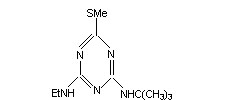|
Terbutryn
|
|
Chemical name: |
Terbutryn |
|
CAS No.: |
886-50-0
|
|
Empirical formula: |
C10H19N5S 5
|
|
Structural formula: |
 |
|
Molecular mass: |
241.4 |
|
Basic chemical and physical data: |
The pure Terbutryn is white crystal, m.p. 104 – 105℃, vapor pressure 0.128mPa at 20℃. Solubility in water: 58mg/L (20℃); it is steadily soluble in organic solvents.
This material is stable in normal conditions, but it will decompose in strong acid or strong base. This material is non-flammable, non-explosive, and non-corrosive.
|
|
Usage: |
Terbutryn is used as a selective triazine herbicide. It is used to control the weeds in the fields of winter wheat, barley, sorghum, heliotrope, potato, pea, soybean, earthnut etc. Application after seeding and before seedling, the persistence in soil will be 3 – 10 weeks. |
|
Toxicity: |
The acute oral LD50 for rats is 2400 - 1980mg/kg, the acute dermal LD50 for rats is more than 5000mg/kg. The NOEL 90-days on dog is 40mg/kg/day. |
|
Storage: |
Terbutryn shall be stored in a cool, dry and well ventilated place. It should not be stored or transported along with foods. |
|
Package: |
25kg woven bag, or 500kg big-bag, or according to the customer’s requirements. |
|
Attention: |
1. The area of field shall be measured accurately, otherwise Terbutryn possibly bring the hazards to the corps.
2. Terbutryn is not suitable for the usage in the sandy field which contains low organic elements.
3. Terbutryn is a slightly toxic pesticide. But people shall protect themselves when they formulate and use Terbutryn.
|
|
Formulation: |
50%SC,80%WP |
|
|
|
|
Specification of technical: |
|
|
Appearance: Off-white powder
Content of A.I.: 97.0% min.
Content of NaCl: 1.0% max.
Loss on drying: 1.0% max.
Fineness (pass through 325 mesh sieve): 98.0% min. |